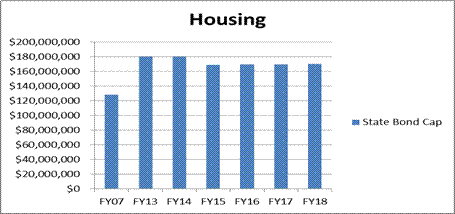FY2014 - FY2018 Capital Investment Plan
Report - Investment Category - Housing
The Department of Housing and Community Development (DHCD)
administers eight capital programs, all of which are critical to the
Department’s mission. These programs have the capacity to produce or preserve
affordable units, create housing opportunities for special populations and
create housing for homeless individuals and families who currently live in
shelters or overflow facilities. Some of the programs focus on helping people
with disabilities move from nursing homes or other institutions into
comfortable settings with appropriate services. Other programs can be used to
create housing for veterans who have served in combat and are readjusting to
civilian life. Every capital program administered by DHCD can support the
creation of additional units to serve homeless individuals and families. The
creation of permanent housing for this population is critically important for
many reasons. In addition to achieving social goals, it also relieves pressure
on the Commonwealth’s operating accounts that support homeless shelters and
overflow facilities. DHCD capital programs provide for construction of new
units as well as preservation of affordable family units that help to stabilize
and advance neighborhood housing efforts, many of which are close to transit
and within walking distance of retail and commercial opportunities.
The following graph reflects the Administration’s estimated
capital investment in affordable housing projects and programs over the next
five years, as compared to fiscal years 2007 and 2013 economic development
related spending.

Administration Accomplishments to Date
Public Housing
- Governor Patrick
inherited a neglected public housing system with a backlog of expired
building systems and deferred maintenance, and he dramatically increased
the Commonwealth’s capital investment in public housing to begin to
address this challenge.
- In June 2010, DHCD initiated a formula funding program
to ensure that capital funds awarded to state-aided public housing are
distributed in an equitable, transparent and predictable manner. Now,
every local housing authority (LHA) annually receives a share of available
funds proportional to its condition-based need.
- DHCD has made significant strides in the capital
planning process with technological improvements that include a
comprehensive web-based system to target funding to greatest needs and measure
the effectiveness of capital improvement projects.
- DHCD,
with support from the LHAs, has nearly completed the process of
federalization 3,856 public housing units scattered across 48 sites and 19
LHAs at a cost of approximately $38 M in capital funds. The
federalization of these units will transfer $100 M in capital liability to
HUD and will increase operating funds to federalized units by at least
30%, as well as free up much needed state operating funds for the state’s
remaining public housing portfolio.
- Initiated
in 2008, the Sustainability & Energy Program has infused “green”
approaches into capital planning and construction standards, helped
housing authorities address energy planning and leveraged substantial
outside resources from utility energy efficiency programs, government
agencies and innovative financing programs.
- The
Vacant Unit Turnover Initiative, funded at $2 M each year, led to the
rehabilitation and reoccupation of more than 400 units that had been
sitting vacant for 60 days or more in the past 2 fiscal years.
- On
January 1, 2013, DHCD implemented a new policy designed to hold housing
authorities more accountable for the speed at which they reoccupy vacated
public housing units, by assessing fees for unnecessarily slow turnovers.
Combined with $2 M in continued capital assistance for the most costly
turnovers, the percent of units turned over in under 60 days increased by
15%.
Housing Development
- Over $518
M in bond program funding has been awarded to 392 projects in 129 cities
and towns across the Commonwealth.
- 15,981
units of housing for individuals and families have been developed and/or
preserved.
- Over
935 homes have been modified to increase accessibility/improve safety for
households with persons with disabilities.
- 20,142
jobs have been created for Massachusetts workers.
- Approximately
$1.94 B has been leveraged in other local, state and federal sources.
FY14 Highlights
- The Commonwealth
will repair, modernize and reoccupy an additional 175 to 225 vacant public
housing units through a $4 M investment, with a special emphasis on
certain long-term vacancies that are more costly to rehabilitate than past
units served by this initiative.
- Continuing
the Administration’s commitment to the sustainability of public housing,
an investment of $3 M will be made at developments with the highest
electricity, gas and water usage. Capital projects will include: more
low-flow toilet replacements, HVAC system upgrades, building envelope
upgrades, lighting, insulation and energy-efficient refrigerators.
- The
health and safety of public housing residents will be ensured by investing
$5 M in targeted risk-management projects such as:
- Hazard mitigation at site and
common areas;
- Design of second elevators at
select multi-story, single-elevator, elderly buildings; and
- Installation of emergency power
generators at select multi-story elderly buildings with elevators.
- The
Commonwealth will continue to preserve public housing developments with
the highest capital needs, while simultaneously leveraging millions of
dollars in non-state funds through the High Leverage Asset Preservation
Program (HILAPP). $1 M of pre-development funds will be awarded for major
modernization projects that are beyond the reach of formula funding.
- A
one-time, $10 M additional investment in Affordable Housing for Priority
Populations projects will be funded in FY14. This additional capital
funding capacity will allow DHCD to create additional housing options for
priority populations, including the chronically homeless, veterans and
others in need of supportive housing.

